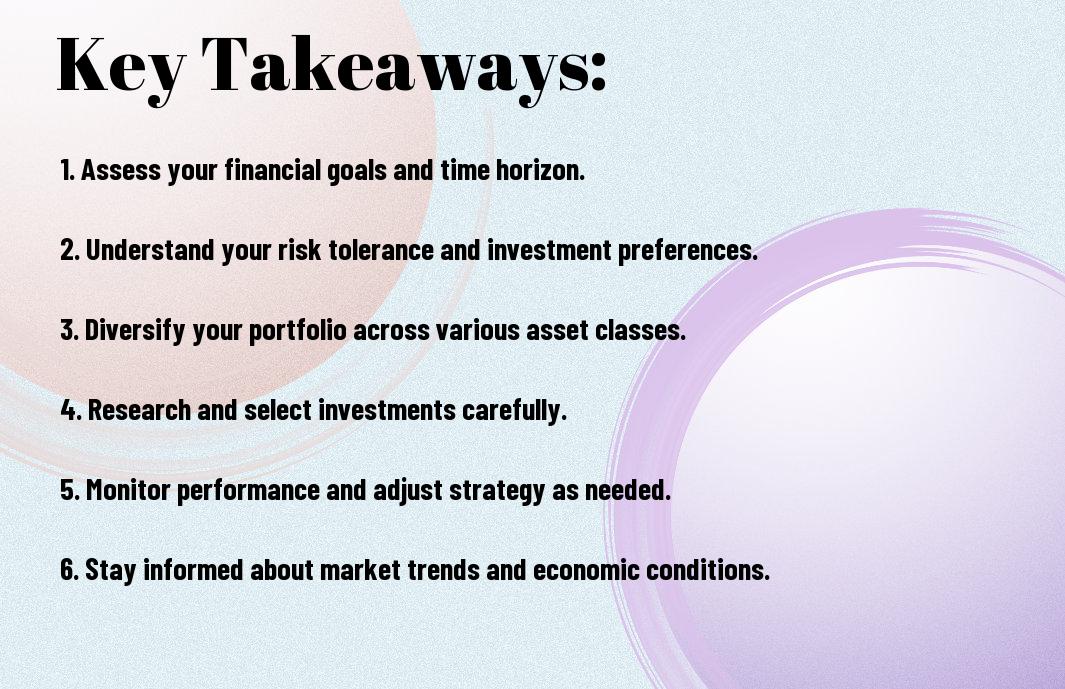With the right approach, you can build a personalized investment strategy that aligns with your financial goals and risk tolerance. This guide will walk you through the imperative components of creating your investment plan, helping you navigate the complexities of the market. Start by assessing your financial situation and considering your long-term objectives. For a detailed breakdown, you can refer to Making an Investment Plan: A Step-by-Step Guide, which offers valuable insights into effective investment planning.
Key Takeaways:
- Define Your Goals: Establish clear financial objectives, whether they are short-term or long-term, to guide your investment decisions.
- Understand Your Risk Tolerance: Assess your comfort level with risk to find investments that align with your personal financial situation.
- Diversify Your Portfolio: Spread investments across various asset classes to mitigate risks and increase potential returns.
- Stay Informed: Regularly review financial news and market trends to make informed decisions and adjust your strategy as needed.
- Develop a Regular Investment Schedule: Consistently invest over time to take advantage of market fluctuations and benefit from dollar-cost averaging.

Understanding Your Financial Goals
To create a personal investment strategy, it’s important to clearly define your financial goals. Identifying what you want to achieve with your investments will guide your decisions and help you align your strategies accordingly. You may aim for retirement savings, purchasing a home, or funding education. Each goal has its timeline and specific requirements, making it crucial to assess your objectives early on in the planning process.
Short-term vs. Long-term Goals
Before you outline your investment strategy, distinguish between your short-term and long-term goals. Short-term goals typically involve needs or aspirations within the next few years, such as building an emergency fund or saving for a vacation. Long-term goals, on the other hand, extend over several years and can include retirement savings or funding your children’s education. Understanding this distinction helps you tailor your investments to meet these varying timelines effectively.
Risk Tolerance Assessment
Before formulating your investment strategy, assess your risk tolerance. This involves evaluating how much risk you are willing and able to take with your investments, as this will significantly influence your choice of assets. A comprehensive understanding of your risk tolerance ensures that you select investments that can withstand market fluctuations while aligning with your financial objectives.
Goals play a significant role in determining your risk tolerance. Factors influencing your comfort level with risk include your investment horizon, financial situation, and personal preferences. If you are saving for a near-term goal, you may prefer a conservative approach, while those with long-term goals might lean towards more aggressive investments. Regularly reevaluating your risk tolerance is crucial, as life circumstances and market conditions can change over time, impacting your investment strategy accordingly.

Analyzing Your Current Financial Situation
Any effective investment strategy begins with a thorough analysis of your current financial situation. This involves taking stock of your income, expenses, and any existing financial commitments. By assessing these factors, you can identify areas for improvement and set realistic investment goals that align with your overall financial health.
Assessing Income and Expenses
Above all, understanding your income and expenses is vital to crafting a successful investment strategy. Start by tracking all sources of income and categorizing your expenses. This will help you identify how much disposable income you have available for investment, ensuring that you’re investing from a position of financial strength.
Evaluating Existing Investments
Across your financial landscape, evaluating your existing investments is a key component of the analysis process. By reviewing what you already own, you can determine how well they align with your current financial objectives and risk tolerance. This assessment helps you identify underperforming assets, opportunities for reallocation, and the overall suitability of your investment portfolio.
Another important aspect of evaluating existing investments is understanding their performance over time. Look into the returns generated, risk levels, and how your investments fit within your long-term financial plans. This reflection not only allows you to make informed decisions about future investments but also helps you fine-tune your strategy to better meet your specific financial goals.
Researching Investment Options
Keep an open mind as you explore various investment options that align with your financial goals. It’s crucial to gather information on different investment vehicles, including stocks, bonds, and mutual funds. For a comprehensive guide to get started in this realm, refer to How to Start an Investment Portfolio. Understanding the nuances of these options can help you make informed choices.
Stocks, Bonds, and Mutual Funds
About stocks, bonds, and mutual funds: these are foundational components of many investment portfolios. Stocks represent ownership in a company and have the potential for high returns. Bonds are less volatile, offering steady income through interest payments, while mutual funds allow you to invest in a diversified collection of stocks and bonds, reducing risk.
Real Estate and Alternative Investments
Alongside traditional assets, consider real estate and alternative investments in your strategy. Real estate can provide rental income and appreciation over time. Alternative investments, such as commodities or collectibles, can diversify your portfolio but often require specialized knowledge.
Hence, exploring real estate and alternative investments can be a valuable addition to your overall strategy. These options often provide a hedge against inflation and can yield significant returns when approached thoughtfully. Evaluate your personal risk tolerance and investment horizon when delving into these areas to ensure they align with your broader financial objectives.
Building Your Investment Portfolio
Despite the overwhelming choices available, building your investment portfolio can be streamlined by focusing on your financial goals and risk tolerance. Explore 5 Popular Investment Strategies For Beginners to gain insights into various approaches that could suit your unique circumstances. A well-structured portfolio should align with your objectives while also adapting to market changes.
Diversification Strategies
Among the most effective ways to mitigate risk in your investment portfolio is through diversification. By spreading your investments across different asset classes, industries, and geographies, you can avoid the pitfalls of being overly concentrated in a single area. This strategy helps to cushion your portfolio against market volatility, enhancing the potential for consistent returns.
Asset Allocation Techniques
Beside diversification, applying effective asset allocation techniques is crucial for a balanced investment portfolio. This approach determines the proportion of various asset categories—like stocks, bonds, and cash—that you hold, based on your risk profile and investment timeframe. Proper asset allocation is key in aligning your investments with your financial objectives.
A common asset allocation strategy is the age-based model, where your risk tolerance typically decreases as you age. Younger investors may favor a higher percentage of stocks, capitalizing on growth opportunities, while those nearing retirement might shift toward more stable bonds to preserve wealth. Evaluating your risk appetite and adjusting your allocation periodically helps ensure your portfolio evolves to meet your long-term goals.
Monitoring and Adjusting Your Strategy
Now that you have established your personal investment strategy, the next step is to monitor its progress and make necessary adjustments over time. Market conditions, personal circumstances, and investment goals can change, so staying informed and proactive will help you remain aligned with your objectives and ensure long-term success.
Regular Reviews and Performance Tracking
Your investment strategy requires consistent evaluation to determine its effectiveness. Conducting regular reviews and tracking performance against benchmarks allows you to gauge how well your investments are performing and make informed decisions about any adjustments needed along the way.
Rebalancing Your Portfolio
Below is the importance of maintaining a balanced investment portfolio. Over time, certain assets may outperform others, causing your original asset allocation to drift. Regularly rebalancing your portfolio helps in realigning it with your investment goals and risk tolerance.
Even small deviations in asset allocation can significantly impact your portfolio’s performance over time. By rebalancing, you can take profits from high-performing assets and reinvest them into undervalued ones, thereby maintaining your desired risk exposure and investment strategy. This disciplined approach ensures that you do not become overly reliant on particular assets as markets shift, safeguarding your long-term financial objectives.
Seeking Professional Guidance
For many individuals, navigating the complexities of investment can be daunting. Seeking professional guidance from a financial advisor can help you design an investment strategy tailored to your unique goals, risk tolerance, and time horizon. A knowledgeable advisor can provide valuable insights into market trends, investment opportunities, and help you stay disciplined during market fluctuations, ultimately leading to more informed investment decisions and better financial outcomes.
When to Consult a Financial Advisor
Around significant life events such as marriage, retirement, or inheritance, it might be wise to consult a financial advisor. These milestones can have a profound impact on your financial situation and investment strategy. A professional can help you reassess your goals and make necessary adjustments to your investment portfolio, ensuring that you are on track to achieve your objectives.
Understanding Fee Structures
Above all, understanding the fee structures associated with financial advisors is imperative for managing your investment costs. Fees can vary widely among advisors, often impacting your overall returns. It’s important to know whether your advisor charges a flat fee, hourly rate, or a percentage of your assets under management, as well as any additional costs, such as commissions or fund expenses.
Also, when discussing fees with a financial advisor, ensure that you are clear on the value being provided in return for those costs. Some advisors may work on a fee-only basis, meaning they receive payment solely from their clients and do not earn commissions on product sales. This can lead to fewer conflicts of interest. You should feel comfortable asking questions about how fees are structured and what alternatives are available to ensure you’re making a sound investment. Transparency in fees and services will help you make informed decisions about your financial future.
Conclusion
From above, you’ve learned that creating a personal investment strategy involves assessing your financial goals, risk tolerance, and time horizon. By diversifying your portfolio and continuously educating yourself, you can make informed decisions that align with your objectives. Establishing a regular review process will help you adapt your strategy to changing circumstances. Ultimately, taking these steps will empower you to manage your investments effectively, leading to greater financial security and potential long-term growth.
Q: What are the key components of a personal investment strategy?
A: A personal investment strategy typically includes several key components: investment goals, risk tolerance, asset allocation, investment horizon, and regular evaluation. Setting clear investment goals helps you define what you want to achieve, whether it’s saving for retirement, a home, or education. Risk tolerance assesses how much volatility you are comfortable with in your investments. Asset allocation determines how to spread your investments across various asset classes, such as stocks, bonds, and real estate. The investment horizon identifies the time frame for your investments, while regular evaluation ensures that your strategy remains aligned with your goals as your situation changes.
Q: How do I assess my risk tolerance for creating a personal investment strategy?
A: Assessing your risk tolerance involves understanding your financial situation, investment experience, and comfort level with market fluctuations. You can start by reviewing your current financial health, including income, expenses, savings, and investment experience. Online questionnaires or surveys can also help gauge your risk preferences. Additionally, consider how you would react to potential losses; if a market downturn would cause you significant stress, you may be more risk-averse. Your risk tolerance should align with your investment goals and time horizon.
Q: How often should I review and adjust my investment strategy?
A: It’s advisable to review your investment strategy at least annually or whenever you experience significant life events, such as a career change, marriage, or the birth of a child. Regular reviews can help you assess whether your investments remain aligned with your goals and risk tolerance. Market conditions and economic factors can also impact your strategy, so staying informed about relevant trends can inform necessary adjustments. Ultimately, your investment strategy should be flexible enough to adapt to both personal and market changes.

